Dispatch: May 21, 2006
|
|
Lat/Long: S-064 20.415 W-062 59.829
Temperature: -3.2 degrees Centigrade
Wind Chill: -3.8 degrees Centigrade
Wind: Light S about 5 km/h
Day's menu: Pepper steak, fish, mixed corn vegs, salad; Vegetable quiche, pork chops, roast potatoes, rice, cream of broccoli soup, green beans, salad, cheesecake, sheet cake and cookies.
Ay, Caramba!! Woke up (the other side of having been asleep!) this morning to calm waters and land! It's the most beautiful landscape you'll ever see. Looming, large, oh, so large. Toto, hold on to those ruby slippers for now, I'm stayin'!!
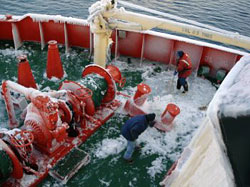
Gustavo Canas and Emilio Sorio chop ice off of the foredeck.
(Photo by Cpt. Martin Galster)
|
The decks are a-buzz with activity. First and earliest, the deck hands were out with large rubber mallets, 'hammering' the ice off the decks, rails, and necessary equipment (including the zodiac).
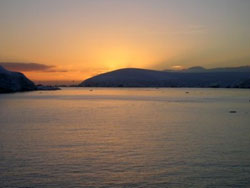
Abandoned Argentine station in cut, left of center. Sunrise.
(Photo by Ellen Bailey)
|
We are at this location on a mission to deliver supplies food, a generator to a Canadian crew anchored near an abandoned station that we can see from the ship.
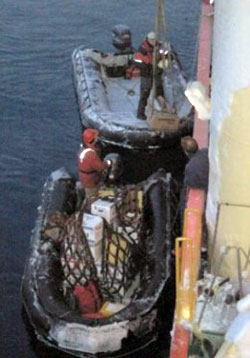
Loading supplies for Canadian boat and crew. (Photo by
Cpt. Martin Galster)
|
Our inflatable plus two of theirs get into the fray of delivery and retrieval. They deliver to us their ...refuse, and retrieve from us their needed cargo. The LMG is hovering (not anchored) about a mile from where the Canadian boat is anchored. It took nearly 2 hours to make the exchanges.
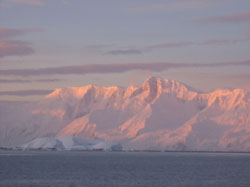
Dallmann Bay. (Photo by Steve Rupp)
|
Decks are open again, the water is like glass, everyone is out, and the Camera is King. We are in Dallmann Bay near the Melchior Islands, all named for Greek letters. One is round-topped, another jagged, another appears mostly made of snow and ice with huge crevasses making it look like it's about to break apart. It seems more like a harbor because of the overlapping of islandscape. Grey, then gray-blue, then 'sky blue pink' (Pam) and pink and finally white.
The sun is fully up around 10:00, and at its peak is not higher than the island mountain peaks themselves. We'll enjoy the sun's light until maybe 3:30pm and then the moon and its accompanying planet (Venus?) will reign over the mountained horizon again.
This bay is flat calm, and the water is pockmarked with small icebergs. We can see by its gray hue that the water surface is freezing closer to shore. Izzy Williams spotted some “mammal activity!!” in the distance, near that gray frozen zone. We were able to identify a pod of killer whales, orcas, feeding about 1.5 miles away! When the philanthropic exercise was over, Larry Brissette (3rd Mate) maneuvered the ship nearer to the whales so we could watch them and capture them on film. Everyone (except Larry, of course) was out on the bow trying to catch an image of the beauty that would do them justice tall black fins and bodies glinting in the sun, about 10 or so whales with the Antarctic skyline in the background.
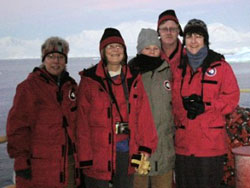
Camera clique E. Bailey, P. Polloni, R. Waller, W. Jaeckle,
S. Balser.
|
Getting to Know You
Orcinus orca, the Killer Whale, is the largest member of the dolphin family. It is usually seen feeding at the ice edge as well as in open Antarctic waters, and usually in close herds of 5-10. Orcas feed on fish, squid, penguins and other seabirds, seals, and dolphins. Herds usually contain adults of both males and females, as well as calves and juveniles, with the oldest female usually being dominant (and adult males frequently her offspring). Its blow profile is low and bushy rather than vertical. The dorsal fin on the male is tall and straight, compared to the female's shorter and sometimes curled fin. They have distinctive black and white coloring, including a large oval spot above each eye. (We saw a herd of maybe a dozen orcas of all sizes, including a fairly small calf. This source indicates that calves are usually born in autumn and winter, so this may have been quite a new baby.)
[Shirihai, H. 2002, A Complete Guide to Antarctic Wildlife, The Birds and Marine Mammals of the Antarctic Continent and the Southern Ocean. Finland: Alula Press Oy]
Back to the Science
Plankton tows were done in the Bay with great success with several of the larval types Rudi Scheltema is especially looking for (including bipinnaria and brachiolaria [adult = starfish], pilidium [worm], spionid [worm]), and tonight we are steaming to another waypoint to perform a full set of tows and a benthic dredge. In the morning we will arrive at Palmer Station.
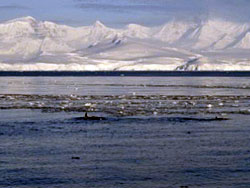
Catch of the Day. (Photo by Ellen Bailey)
|
Catch of the Day
Andy Mahon provided this shot of the orcas in Dallmann Bay.
back
|
|